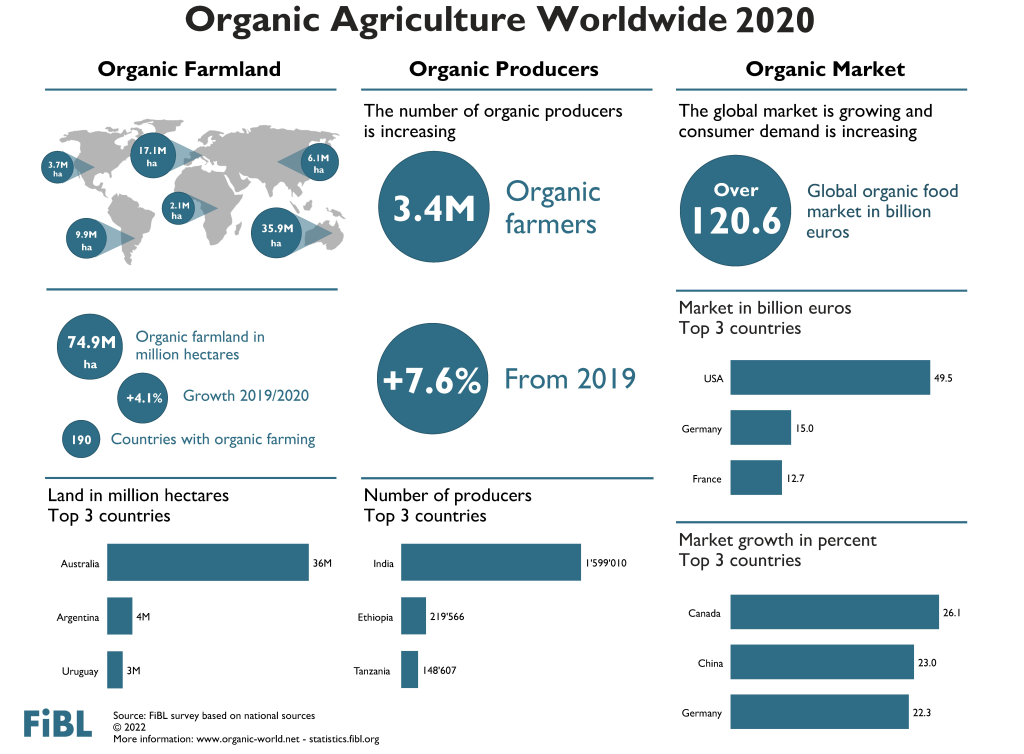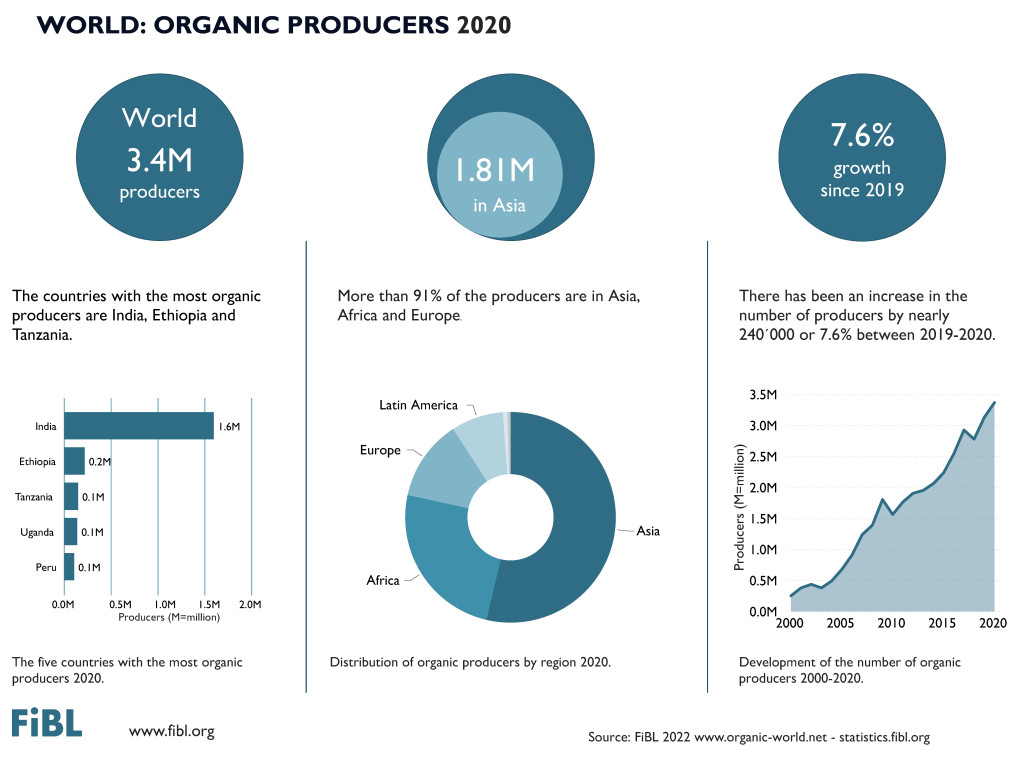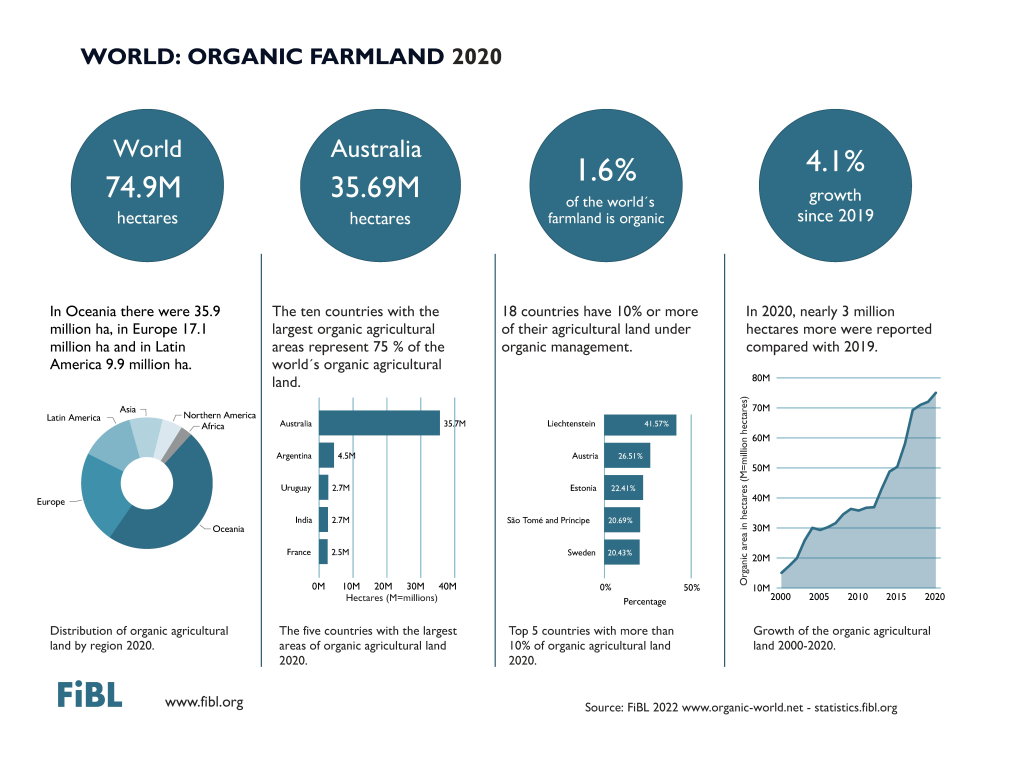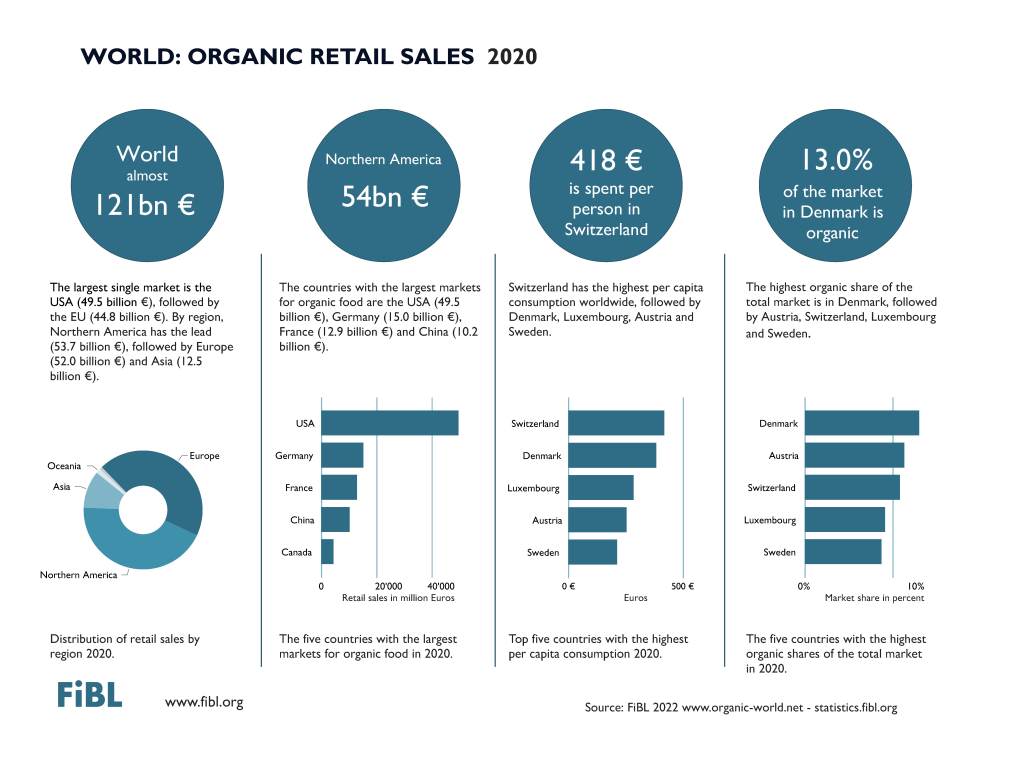MESSAGE FOR 2022
IN THE LAST 40 YEARS AGRICULTURE HAS GIVEN MAJOR CHANGES
ORGANIC HAS ALWAYS BEEN AT THE FOREFRONT OF CHANGE SINCE THE BEGINNING
“There is the risk you cannot afford to take, and there is the risk you cannot afford not to take.”
Peter Drucker
Botucatu, December 13, 2021
In the last 40 years, agriculture has gone through several and profound transformations. Partly out of self-criticism, looking for improvements on its own, and partly – more strongly – out of consumer pressure.
Historically (1), in development processes and in new technology transformation revolutions, the adherence to the process by the overwhelming majority of producers occurs when there is a real and convincing technology that the majority adopts. We cannot yet say that about organic agriculture, although there are strong indications of expansion trends in other countries, but not in Brazil. See today the three countries with the highest number of registered certified organic producers and the global market estimate below. However, in Brazil, we still haven’t reached even 1% of Brazilian producers (we currently have approximately 26,000 producers, with 1% equivalent to 55,000 producers). In terms of area, even estimating a total of 1.5 million hectares (estimated, as we do not have official data available), we have in Brazil about 20% of area dedicated to agriculture. Organic agriculture in Brazil would thus occupy 0.88% of the cultivated area.
From a monetary point of view, it is estimated, roughly, the turnover with organic products of 1 billion dollars. Comparing with the world billed with organic, US$ 132 billion (2), again we have that Brazil participates with 0.75% of the global movement of organic markets. Comparing with the total of Brazilian agribusines (3), organic earns 0.83%. (4). There is a desire, yes, around sustainable or regenerative agriculture – but adherence by the majority is not yet the reality. There’s still a lot to do for organic!
(1) – Thomas S. Kuhn- The Structure of Scientific Revolutions, Second Edition, Enlarged. University of Chicago, 1970. “Scientific revolutions are here considered those non-cumulative developmental episodes in which an older paradigm is replaced in whole or in part by an incompatible new paradigm.”
(2) Willer, Helga, Jan Trávníček, Claudia Meier, Bernhard Schlatter (Eds.) (2022): The World of Organic Agriculture. Statistics and Emerging Trends 2022. Research Institute of Organic Agriculture FiBL, Frick, and IFOAM – Organics International, Bonn. Available at www.organic-world.net/yearbook/yearbook-2022.html.
(3) https://exame.com/agro/recorde-apos-recorde/
(4) we consider here organic agriculture encompassing all concepts, such as biodynamics, agroecology, regenerative, syntropic, natural and others.However, based on the facts reported below, we can say that organic agriculture has always signalled, indicated the paths of transformation.
However, based on the facts reported below, we can say that organic agriculture has always signalled, indicated the ways of transforming agriculture today, serving as inspiration and criticism of the current system. We must, however, humbly admit that technologically there is still much to be done in organic!
1- Organic agriculture has always prioritized biodiversity. In the micro scenario, through the development of techniques that prioritize the biodiversity of animals, insects and fungi present at the place of production, as a strategy for maintaining balance.
One of the main techniques advocated by the organic sector was biological control, natural or artificial, promoting environments favourable to natural predators of pests or their introduction into commercial crops. Today, biological control represents the new revolution in world agriculture, effectively and decisively helping to reduce the use of pesticides.
Furthermore, with regard to insects, the importance of having this ‘organ’ well developed on farms has always been highlighted, both for natural enemies and for bees – so important for pollination and for the productivity of crops, which depend on pollination. crusade. Without the use of pesticides, maximum activity and performance of these insects is guaranteed. Nowadays, the mortality of bees and meliponids (a fact that had already been predicted by the pioneers of organic agriculture) is a central topic of discussion about the future of agriculture, remembering that in China there are already regions where pollination in fruit trees is human. and no longer carried out by insects…because they no longer exist in those environments with extreme use of pesticides.
In the macro scenario, organic agriculture conserves and enhances biodiverse environments such as forests, live fences, protection of watery areas and others.
Many countries did not have or still do not have a strict environmental law like the Brazilian one. The introduction of areas of environmental recovery in percentages around 10% of the production area was something that happened worldwide and brought clear advantages to organic producers. In Brazil, we already have examples of organic production that exploit its biodiversity, including in fields, to reduce the population of “pest” insects.
2- Organic agriculture has always prioritized soil organic matter, with the incorporation of compost or with superficial laminar application, for its ability to increase soil buffering power, aggregation of nutrients, improve soil structure, promote soil life – which mobilizes and makes nutrients available to plants. The retention of organic matter leads to the retention of carbon, a very important factor for mitigating the damage caused by greenhouse gases, in addition to helping to add nutrients to the soil, saving the use of imported fertilizers.
3- Organic agriculture, since the beginning, has always prioritized the use of natural fertilizers and ground rocks. Non-organic agriculture uses limestone, a ground rock, to neutralize the pH of the soil; organic also does it, but in addition to limestone, it has always supported and encouraged the use of other rocks such as natural phosphates, basalts, granites and feldspars, rich in minerals that, once in the soil, worked by the biota, decompose quickly, releasing nutrients , helping to build the soil nutrient bank, promoting the local solution of fertilization and the correction of soil fertility. Non-organic agriculture has created, in recent decades, a huge dependence on imported fertilizers, paid in dollars. Regarding this topic, we will still have major developments in the coming years. Recent articles, due to the international crisis and the war in Ukraine, show that the country Brazil is waking up to the street natural wealth, igneous, sedimentary and metamorphic rocks available for agriculture in ground form.
4- In this vein, the integration of cultures and creations in rural properties has always been the prioritized form in organic agriculture. It helps in the recycling of nutrients, in animal comfort, and today the importance of crop, livestock and forest integration is recognized in Brazil as an important and decisive solution for the production of lasting production systems, a system that is exemplarily defended by Embrapa.
5- The issue still present in everyone’s memory, the mad cow, which had also been foreseen by the pioneers of organic agriculture, demonstrated that the aptitudes of each species of animal and form of feeding must be respected, creating mechanisms to guarantee quality of origin and traceability of feed supplied to animals. In organic agriculture, animal feed was already fully tracked. The issue of food quality and its traceability has always existed in organic farming. Traceability has become the absolute minimum, it is part of the basic set of good production practices. Without it, any certification process, not just the organic one, is lost. The more detailed the traceability, the safer the process and the product. With it, it is possible to define and segregate the problems, the risk factors. With trade reaching global, transnational or even continental proportions as in Brazil, it becomes a fundamental criterion for the success of any agricultural enterprise. Both for those who produce food and for those who supply raw materials.
Because of these factors and others not yet mentioned that could be added to this list, I am confident that organic agriculture is one of the inspirations for the right path today, is desired by consumers and will continue to impact society. The above-described items are part of the ongoing development needed in agriculture.
Because of these factors and others not yet mentioned and that could be added to this list, I have the peace of mind and the certainty that organic agriculture is one of the inspirations for the right path today, is desired by consumers and will continue to have an impact on society. The above items are part of the ongoing development needed in world agriculture as a whole.
In relation to organic agriculture, there are many challenges that still exist, such as the creation of a no-till system with inputs and methods approved for this system.
“The global organic food market size is expected to grow from 2021 to 2022 at a compound annual growth rate (CAGR) of 14.0%.” (Business Research Company). How can we participate and grow with this market? It´s development is only beginning. It is possible to understand the organic world through it´s segmentation and trends. “…Poultry and Dairy, Organic Fruits and Vegetables, Organic Bread and Bakery, Organic Beverages, Organic Processed Food, Others” (Business Research Company) is a way to understand it. Poultry in Brazil for instance is one of the fastest growing segments in organic. Organic egg consumption exploded during the pandemic, the search for grains to feed the laying hens also. All trends and policies launched in developed countries for organic promotion impact directly those countries where the programs are launched but also the whole world. For instance: in promoting organic grains and dairy in Europe (who wants 25% acreage covered with organics by 2030- https://www.foodnavigator.com/Article/2021/04/12/Europe-s-difficult-target-of-25-organic-by-2030-Is-the-Organic-Action-Plan-doing-enough) , automatically the demand in tropical countries for sugar, coffee and cocoa also increases, because the dairy and grains will be consumed adding the tropical products also. All is interconnected- this the organic production system has already indicated since the beginning. Research in important and access to market studies also.
Organic and sustainable certification support progress in this development, with clear criteria, evaluated and maintained for product producers and processors, with standards decided after consultation with operators and stakeholders.
Fulfilling the QIMA IBD mission becomes more important than ever, to help the planet in the pursuit of sustainability. We can do our part!
Alexandre Harkaly
CEO
QIMA IBD



